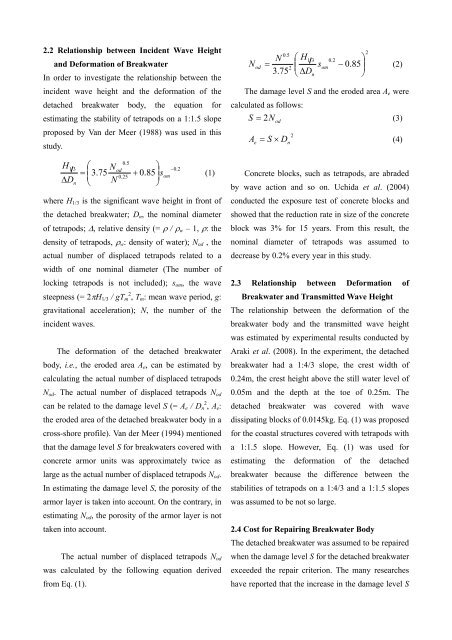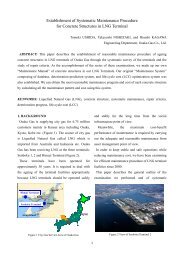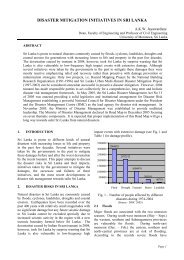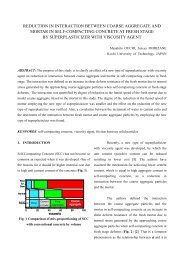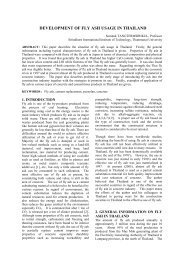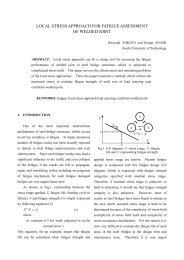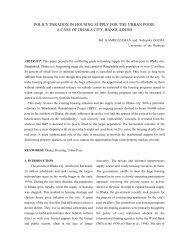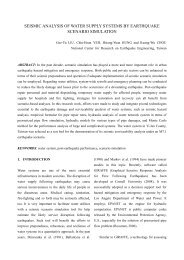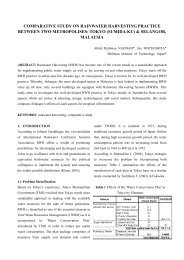estimation of expected repair cost for detached breakwater
estimation of expected repair cost for detached breakwater
estimation of expected repair cost for detached breakwater
You also want an ePaper? Increase the reach of your titles
YUMPU automatically turns print PDFs into web optimized ePapers that Google loves.
2.2 Relationship between Incident Wave Height<br />
and De<strong>for</strong>mation <strong>of</strong> Breakwater<br />
In order to investigate the relationship between the<br />
incident wave height and the de<strong>for</strong>mation <strong>of</strong> the<br />
<strong>detached</strong> <strong>breakwater</strong> body, the equation <strong>for</strong><br />
estimating the stability <strong>of</strong> tetrapods on a 1:1.5 slope<br />
proposed by Van der Meer (1988) was used in this<br />
study.<br />
H<br />
1 3<br />
D<br />
n<br />
N<br />
<br />
3.75<br />
N<br />
0.5<br />
od<br />
0.25<br />
<br />
0.85<br />
s<br />
<br />
0.2<br />
om<br />
(1)<br />
where H 1/3 is the significant wave height in front <strong>of</strong><br />
the <strong>detached</strong> <strong>breakwater</strong>; D n , the nominal diameter<br />
<strong>of</strong> tetrapods; , relative density (= / w – 1, : the<br />
density <strong>of</strong> tetrapods, w : density <strong>of</strong> water); N od , the<br />
actual number <strong>of</strong> displaced tetrapods related to a<br />
width <strong>of</strong> one nominal diameter (The number <strong>of</strong><br />
locking tetrapods is not included); s om , the wave<br />
steepness (= 2H 1/3 / gT 2 m , T m : mean wave period, g:<br />
gravitational acceleration); N, the number <strong>of</strong> the<br />
incident waves.<br />
The de<strong>for</strong>mation <strong>of</strong> the <strong>detached</strong> <strong>breakwater</strong><br />
body, i.e., the eroded area A e , can be estimated by<br />
calculating the actual number <strong>of</strong> displaced tetrapods<br />
N od . The actual number <strong>of</strong> displaced tetrapods N od<br />
can be related to the damage level S (= A e / D 2 n , A e :<br />
the eroded area <strong>of</strong> the <strong>detached</strong> <strong>breakwater</strong> body in a<br />
cross-shore pr<strong>of</strong>ile). Van der Meer (1994) mentioned<br />
that the damage level S <strong>for</strong> <strong>breakwater</strong>s covered with<br />
concrete armor units was approximately twice as<br />
large as the actual number <strong>of</strong> displaced tetrapods N od .<br />
In estimating the damage level S, the porosity <strong>of</strong> the<br />
armor layer is taken into account. On the contrary, in<br />
estimating N od , the porosity <strong>of</strong> the armor layer is not<br />
taken into account.<br />
The actual number <strong>of</strong> displaced tetrapods N od<br />
was calculated by the following equation derived<br />
from Eq. (1).<br />
2<br />
0.5<br />
N H1<br />
3 0.2<br />
0.85<br />
2<br />
3.75<br />
<br />
som<br />
<br />
Dn<br />
<br />
N <br />
(2)<br />
od<br />
The damage level S and the eroded area A e were<br />
calculated as follows:<br />
S 2N od<br />
(3)<br />
A<br />
2<br />
e<br />
S D n<br />
(4)<br />
Concrete blocks, such as tetrapods, are abraded<br />
by wave action and so on. Uchida et al. (2004)<br />
conducted the exposure test <strong>of</strong> concrete blocks and<br />
showed that the reduction rate in size <strong>of</strong> the concrete<br />
block was 3% <strong>for</strong> 15 years. From this result, the<br />
nominal diameter <strong>of</strong> tetrapods was assumed to<br />
decrease by 0.2% every year in this study.<br />
2.3 Relationship between De<strong>for</strong>mation <strong>of</strong><br />
Breakwater and Transmitted Wave Height<br />
The relationship between the de<strong>for</strong>mation <strong>of</strong> the<br />
<strong>breakwater</strong> body and the transmitted wave height<br />
was estimated by experimental results conducted by<br />
Araki et al. (2008). In the experiment, the <strong>detached</strong><br />
<strong>breakwater</strong> had a 1:4/3 slope, the crest width <strong>of</strong><br />
0.24m, the crest height above the still water level <strong>of</strong><br />
0.05m and the depth at the toe <strong>of</strong> 0.25m. The<br />
<strong>detached</strong> <strong>breakwater</strong> was covered with wave<br />
dissipating blocks <strong>of</strong> 0.0145kg. Eq. (1) was proposed<br />
<strong>for</strong> the coastal structures covered with tetrapods with<br />
a 1:1.5 slope. However, Eq. (1) was used <strong>for</strong><br />
estimating the de<strong>for</strong>mation <strong>of</strong> the <strong>detached</strong><br />
<strong>breakwater</strong> because the difference between the<br />
stabilities <strong>of</strong> tetrapods on a 1:4/3 and a 1:1.5 slopes<br />
was assumed to be not so large.<br />
2.4 Cost <strong>for</strong> Repairing Breakwater Body<br />
The <strong>detached</strong> <strong>breakwater</strong> was assumed to be <strong>repair</strong>ed<br />
when the damage level S <strong>for</strong> the <strong>detached</strong> <strong>breakwater</strong><br />
exceeded the <strong>repair</strong> criterion. The many researches<br />
have reported that the increase in the damage level S


